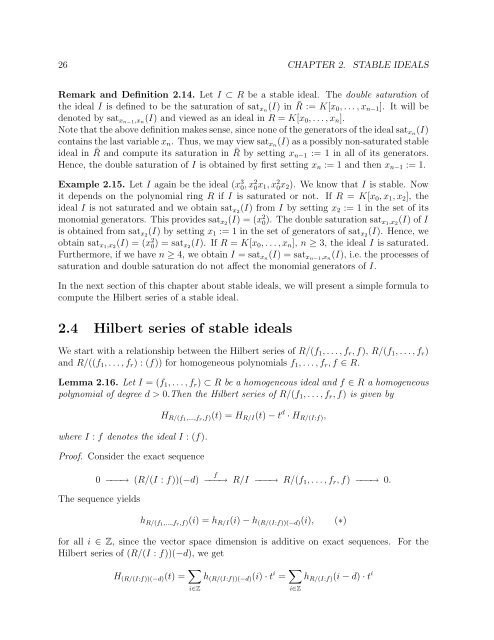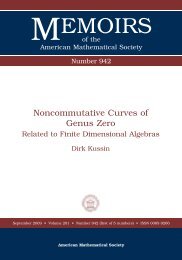University of Paderborn Department of Mathematics Diploma Thesis ...
University of Paderborn Department of Mathematics Diploma Thesis ...
University of Paderborn Department of Mathematics Diploma Thesis ...
Create successful ePaper yourself
Turn your PDF publications into a flip-book with our unique Google optimized e-Paper software.
26 CHAPTER 2. STABLE IDEALSRemark and Definition 2.14. Let I ⊂ R be a stable ideal. The double saturation <strong>of</strong>the ideal I is defined to be the saturation <strong>of</strong> sat xn (I) in ¯R := K[x 0 , . . . , x n−1 ]. It will bedenoted by sat xn−1 ,x n(I) and viewed as an ideal in R = K[x 0 , . . . , x n ].Note that the above definition makes sense, since none <strong>of</strong> the generators <strong>of</strong> the ideal sat xn (I)contains the last variable x n . Thus, we may view sat xn (I) as a possibly non-saturated stableideal in ¯R and compute its saturation in ¯R by setting x n−1 := 1 in all <strong>of</strong> its generators.Hence, the double saturation <strong>of</strong> I is obtained by first setting x n := 1 and then x n−1 := 1.Example 2.15. Let I again be the ideal (x 3 0, x 2 0x 1 , x 2 0x 2 ). We know that I is stable. Nowit depends on the polynomial ring R if I is saturated or not. If R = K[x 0 , x 1 , x 2 ], theideal I is not saturated and we obtain sat x2 (I) from I by setting x 2 := 1 in the set <strong>of</strong> itsmonomial generators. This provides sat x2 (I) = (x 2 0). The double saturation sat x1 ,x 2(I) <strong>of</strong> Iis obtained from sat x2 (I) by setting x 1 := 1 in the set <strong>of</strong> generators <strong>of</strong> sat x2 (I). Hence, weobtain sat x1 ,x 2(I) = (x 2 0) = sat x2 (I). If R = K[x 0 , . . . , x n ], n ≥ 3, the ideal I is saturated.Furthermore, if we have n ≥ 4, we obtain I = sat xn (I) = sat xn−1 ,x n(I), i.e. the processes <strong>of</strong>saturation and double saturation do not affect the monomial generators <strong>of</strong> I.In the next section <strong>of</strong> this chapter about stable ideals, we will present a simple formula tocompute the Hilbert series <strong>of</strong> a stable ideal.2.4 Hilbert series <strong>of</strong> stable idealsWe start with a relationship between the Hilbert series <strong>of</strong> R/(f 1 , . . . , f r , f), R/(f 1 , . . . , f r )and R/((f 1 , . . . , f r ) : (f)) for homogeneous polynomials f 1 , . . . , f r , f ∈ R.Lemma 2.16. Let I = (f 1 , . . . , f r ) ⊂ R be a homogeneous ideal and f ∈ R a homogeneouspolynomial <strong>of</strong> degree d > 0.Then the Hilbert series <strong>of</strong> R/(f 1 , . . . , f r , f) is given bywhere I : f denotes the ideal I : (f).Pro<strong>of</strong>. Consider the exact sequence0 −−−→ (R/(I : f))(−d)The sequence yieldsH R/(f1 ,...,f r,f)(t) = H R/I (t) − t d · H R/(I:f) ,f−−−→ R/I −−−→ R/(f 1 , . . . , f r , f) −−−→ 0.h R/(f1 ,...,f r,f)(i) = h R/I (i) − h (R/(I:f))(−d) (i),(∗)for all i ∈ Z, since the vector space dimension is additive on exact sequences. For theHilbert series <strong>of</strong> (R/(I : f))(−d), we getH (R/(I:f))(−d) (t) = ∑ i∈Zh (R/(I:f))(−d) (i) · t i = ∑ i∈Zh R/(I:f) (i − d) · t i
















